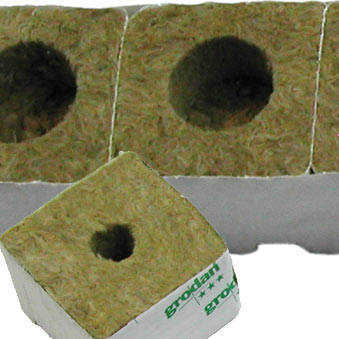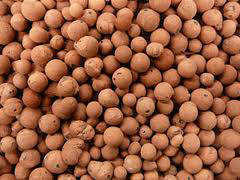Hydroponic, Rockwool, Clay, Perlite Media
There are commercially available growing mixes available that represent excellent value. These will require you to grow the plants in pots and will supply a good, sterile, inert medium that is easy to control and allows for good root formation and aeration. Here we have outlined some of the more popular growing mediums starting with rockwool.
Rockwool

Originally the majority of rockwool was used for insulation purposes however there are many different forms of rockwool with different mineral content and back in the 1960’s they invented a style that works to promote plant growth. This specially produced horticultural rockwool is what is primarily sold as a hydroponic substrate. This comes in a variety of sizes, is very convenient to use and is ideal for growing in large trays.
Rockwool is a man-made mineral fibre mineral or metal oxide made using high heat and air pressure and is a favourite for hydroponics as it can hold a lot of air and water. This ‘breathability’ allows for healthy root growth and quick nutrient uptake. The forest of fibers also makes for a stable platform for cannabis growth as it gives the roots something to latch onto. It is generally used for seed-starting or NFT style grows.
Consider starting off your plants in 1” (2.5cm) cubes. As your plants outgrow these small cubes they fit very nicely into larger cubes without the need to disturb the roots. If you are growing multiple plants you can use rockwool in slabs.
The best rockwool is produced from basaltic rock which has a mineral balance that is inert and non-reactive however rockwool can contain high proportions of metals and may be slightly reactive to the nutrient solution. Be aware that rockwool naturally has a high pH (around 8.0) so you need to get your rockwool from a hydro shop. Although, you can neutralise any high pH by soaking your rockwool in water that you have adjusted to pH 5.5 for an hour or so.

Perlite

Perlite is an amorphous volcanic glass that has been heat expanded and formed into granules. It is pH neutral, is porous, and has excellent water retention and capillary properties. It is quite popular for use in ‘Hempy’ buckets and 2 liter soda bottle SOGs. It has a range of horticultural applications being particularly suitable for transplanting cuttings and seedlings; it’s very light weight also makes it suitable for use with containers.
Perlite can be very dusty which poses a threat of clogging to small pumps. If bought from a garden supplies shop it may also have been treated with fertilizers. Always wash perlite before using in a hydroponic system. The main downside is the dust (be sure to wear a mask when filling containers to prevent lung irritation) and its inability to provide much root stability. It is too light to properly hold a plant of any size without support and is best when mixed with other media.
Vermiculite
Vermiculite is a mineral composed mainly of clay and mica that is expanded under high heat. It is very light and airy and has good water retention. Vermiculite is generally used in conjunction with other media as it is too light to give decent support to the root structure.
Clay pellets
Expanded clay pellets, also known as LECA (lightweight expanded clay aggregate), are formed from small round balls of clay which are heat treated, causing them to expand and become porous and are among the most popular grow media today. They are completely sterile and inert with a neutral pH. They can be sterilized, flushed and re-used and provide good root support, great drainage and aeration.

The porous structure allows the growth of beneficial bacteria and can retain moisture and nutrients quite well. Clay pebbles must be thoroughly washed before each use; initially to get rid of dust and impurities from the manufacturing process, and later to clear out unused nutrients and organic matter. Hydroton is the most popular name brand in the USA, but a new kid in the block, Hydrokorrrels, is gaining in popularity. While the composition is essentially the same, Hydrokorrels were designed specifically for hydroponics while Hydroton was designed for landscaping. The main advantage is an irregular shape which provides a greater surface area for better rooting and holding more nutrients.
Coco or coco-coir
This medium is rapidly growing in popularity. It is made from coconut husk fibers, and unlike peat moss which it replaces, it takes a long time to break down and is reusable. Its harvesting is much better environmentally than destroying bogs to collect peat. The fibers provide good drainage and aeration as well as water retention. It looks somewhat like a rich soil. Coco comes in several different forms: as compressed bricks, croutons, and mats.
Beginner growers are usually better off buying a medium from the store, whether that be brands like Pro-Mix or Sunshine. When you become more advanced you will want to save money by creating your own medium and generally they are created using the same bases such as sphagnum, peat moss or coco coir. To ‘beef’ the volume and create some more air pockets growers like to use lava rocks, wood chips, perlite and vermiculite which will also help keep the roots moist. Coco coir is the fibrous inside of the coconut and is sterilized and dried and due to its form being not too dense or too airy it is a good basis for growing in.

Soil

Soil is a generalized term unlike all the others which refer to a specific substance. It may contain compost, manure, perlite, fir bark, peat moss, sand or other components. Most commercial soils have added fertilizer. One must be careful when choosing as many are too ‘hot’ (contain too much fertilizer so as to burn a plant) for seedlings or young plants. Many indoor growers claim that plants grown in soil have a superior taste to hydroponically grown marijuana based on other grow media.
The main advantages of soil are its natural buffering ability in keeping pH constant and it is very forgiving in the event of electrical or mechanical failure when feeding or watering. While fine forsmall grows, it can become quite expensive, labor intensive and messy for larger indoor marijuana gardens and one must consider the disposal of spent soil.
Good quality commercial potting compost should meet all of your plants’ requirements. It will have the correct texture, water retention and drainage. Some growers like to mix in about 10% perlite, or similar product, to prevent soil compaction and water loss.
- Avoid using soil from the garden as this may harbour pollutants and soil-borne diseases;
- Discard soil when the grow is completed and replace with new soil for each subsequent grow.
When growing hydroponic marijuana indoors most people consider using rockwool or one of the alternate media listed above or a number of them as a mix.


No comments:
Post a Comment